[Photos] A ‘battlefield’ experience in Kinmen: So near, yet so far
Writer Ng Kong Ling takes a trip to Kinmen in Taiwan, and gets a feel of military life, including being up close to a cannon being fired.

(All photos by Ng Kong Ling.)
Kinmen is an important military zone in Taiwan, so much so that it has been called an “outpost of utmost strategic importance”. With its numerous preserved battlefield relics, it has unique tourism offerings.
Many bunkers can be found along its coastline; a broadcast wall continues to play recordings of Teresa Teng’s melodious voice at designated times; a howitzer shows off its operation to sightseers with loud booms; a walk in its mish mash of underground tunnels provides a glimpse into underground life during the war…
Looking across to Xiamen
Kinmen in Taiwan is surrounded by the sea, but offers tourists more than an ordinary island scene. There are no relaxed and carefree beach resorts, nor a wealth of water activities along its coastline; at every beach, one sees bunkers that used to be vital military installations.
At each beach in Kinmen, guides point to Xiamen on the opposite side of the Taiwan Strait as they speak. My local guide or friends also enthusiastically point to the sea: look over in this direction at this angle, and that is a certain place in Xiamen.
Sometimes, one has to use the rows of binoculars, and at other times, it can be seen with the naked eye. Everyone raised their phones and cameras towards the other side, testing the maximum zoom on their lens. But from another perspective, if the lens revealed guns and artillery aimed back at them, that would be scary.
Even though the war ended many years ago and both sides of the strait have changed, what visitors from all over the world talk about the most when it comes to Kinmen is its wartime era. While the page of history has been turned and Kinmen as a battleground is a memory of the previous century, a lot of battlefield relics were preserved, and they are now its precious and unique tourism resources.
Juguang Tower, a landmark of Kinmen
If you only have time for one photo to mark your visit to Kinmen, it has to be Juguang Tower, the most important local landmark and a symbol of its wartime history. Built in 1952, the tower is a fusion of an ancient Chinese style-tower and modern building foundation, to commemorate and honour the heroic exploits of Taiwanese officers and soldiers. Today, the three-storey building is a gallery to introduce local customs and to display historical artefacts.
As the full-size version of the building on the tiny stamp stood before me for real, the solid castle-like building felt especially majestic and indomitable.
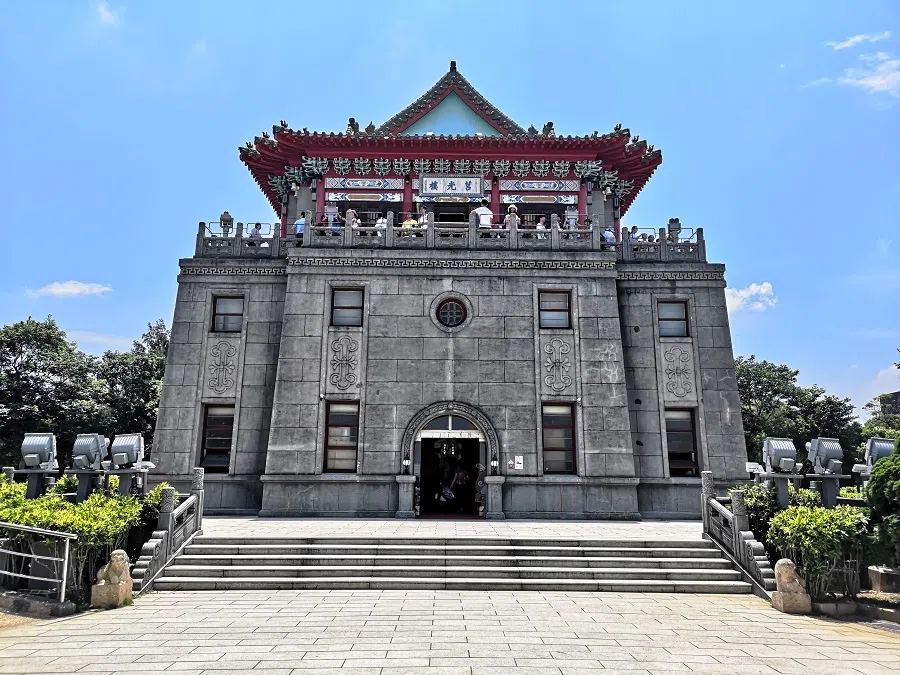
Juguang Tower has been the theme of Taiwanese stamps on many occasions, with the largest volume and longest period of circulation at the Chunghwa Post. As a child, I liked to collect stamps, and collected many Juguang Tower stamps. Its small monochrome design was nondescript, so that when I saw yet another one stuck on a letter, I did not take a second look.
Subsequently, I gradually stopped receiving stamps from Taiwan and stopped collecting stamps, and never thought about where the tower was. And seeing it again randomly one day, the dusty memories within me suddenly surged forth. As the full-size version of the building on the tiny stamp stood before me for real, the solid castle-like building felt especially majestic and indomitable.
Teresa Teng broadcasts
Another keyword associated with Kinmen is Teresa Teng. In her early years, Teng joined the air force military band in performing on the road, including Kinmen. During the war years, propaganda was used in Kinmen as psychological warfare — every day, loud broadcasts would be directed towards the mainland, most famously the warm messages featuring Teng’s dulcet tones.
The surface of an old, well-worn table is full of stories — on it are Teng’s scripts and simple broadcasting equipment, and beside it is a life-size photo of her.



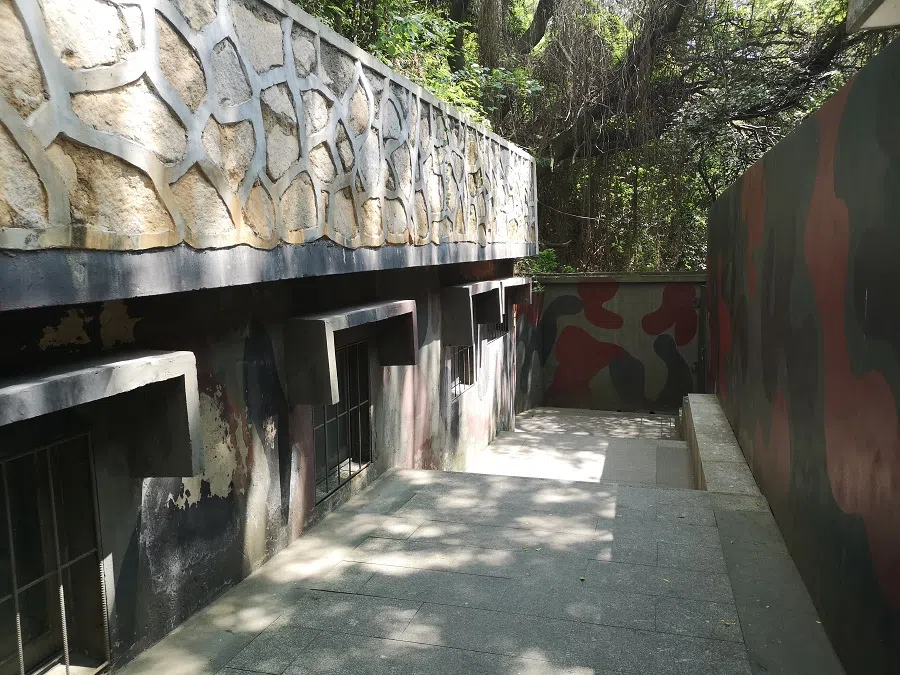
The location of the broadcasts is Mashan, at the northernmost part of Kinmen. As an outpost of utmost strategic importance, Mashan is the point on Kinmen that is closest to mainland China. Go through a narrow walkway and enter the broadcast studio; the hidden underground space looks just as it did before.
The surface of an old, well-worn table is full of stories — on it are Teng’s scripts and simple broadcasting equipment, and beside it is a life-size photo of her. In the gallery, visitors can listen to the broadcast and read the writeups. Behind is the broadcasters’ living quarters, with bedrooms and bathrooms in a cramped pit.
A narrow tunnel leads to the exit at the other end, where one comes out at a bunker-like structure that still bears camouflage paint. Continue exploring along the tunnel, and right at the end finally, there is the light of the outdoors.
An observation station is set in a hidden bunker, with a long, narrow window looking out to the sea carefully designed to be close to the grassy ground. Looking through the binoculars, the opposite side of the strait appears before the eyes, and every movement of the tourists playing on its beach is seen clearly.


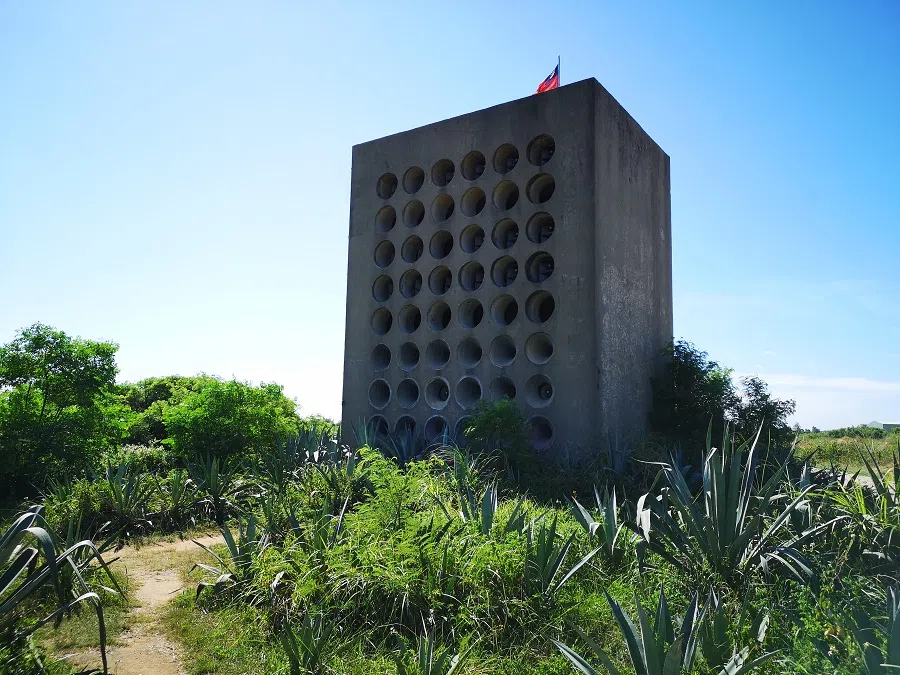

For an authentic experience of Teng’s broadcast, one has to visit the broadcast wall in Guningtou. Many broadcast stations were set up in Kinmen back then; while the Mashan broadcast station was the first to be set up, its original speakers are gone, but the Beishan broadcast wall in Guningtou has been fully preserved.
The broadcast wall here is not concealed, standing proudly near the edge of the Beishan cliff facing the sea. Neatly arranged in the industrial-style grey cement walls are 48 speakers that play Teng’s voice at set times: “Dear mainland compatriots, hello…” followed by familiar songs by Teng.
In those days, the messages were much louder than today, and could be broadcast up to 25 kilometres away. Listening to the familiar sweet vocals float across the sea at high decibels is a unique and melancholy experience.
A battlefield adventure with weapons and live ammunition
Over the past few years, Kinmen has been leveraging its uniqueness as it strives to develop its tourism industry, opening up military premises to the public and making artillery weapons and drills tourist attractions.
The Shishan (Mt. Lion) Howitzer Front near the Shanhou Folk Culture Village is a military facility that has seen actual combat, and is the only remaining howitzer base built in a tunnel in Kinmen. In 2011, it was converted into a tourist attraction and the complete facility is fully open to sightseers.
Its wide tunnels are fully equipped, with a combat readiness room, warehouse, ammunition room, and others. Traces of tunnel excavation can still be seen on the granite walls, on which are also written eye-catching military training slogans.
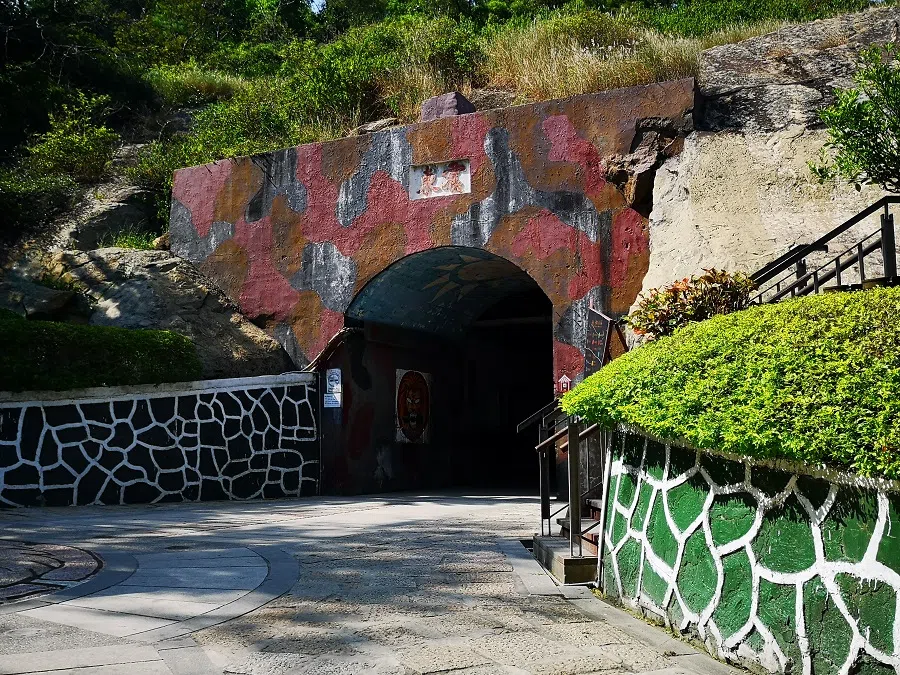






The highlight is a working, US-made 8-inch howitzer with a firing range of 17 kilometres. At designated times, howitzer drill demonstrations are carried out, where soldiers in full battle order march out, head to the front of the howitzer, follow commands and fire the weapon with a deafening boom. Through it all, visitors stand around the cannon and watch, making it feel like one is right there, and reminding one that war is more than a scene in a movie.
What Kinmen has the most of is bunkers and tunnels. Even though popular sightseeing spots like the Mashan Observation Outpost and Shishan Howitzer Front are located in the tunnels, the numerous tourists and spacious premises made them more like tourist attractions and less like a battlefield experience.
Looking inside the mysterious and dark cave, one can see a long tunnel carved out of the rock — narrow, deep, winding and slender, penetrating deep into the earth like a root.
Mysterious underground tunnels
On Lesser Kinmen island in the Lieyu Township, it is quieter with much fewer tourists. This frontline of the battlefield is only six kilometres from Xiamen, and its solemn “underground” atmosphere of tight security leaves an especially deep impression.
A camouflaged bunker is concealed in an inconspicuous corner, and a closer search reveals the even more discreet underground tunnel. Looking inside the mysterious and dark cave, one can see a long tunnel carved out of the rock — narrow, deep, winding and slender, penetrating deep into the earth like a root.

Walking in the tunnel feels very strange. There is no trace of the tunnel from the outside, but enter it and it is an entirely different world. The temperature is a few degrees cooler and the light is dimmer, in stark contrast with the glare and heat outside. Voices and footsteps echo slightly, and the entire space feels changed.
The long, narrow passage does not feel claustrophobic; its neat layout feels like an underground ant kingdom. No one wants to be left behind as we follow our guide. As we move forward step by step through the long tunnel, it feels dreamily surreal, as if at the end of the passage is another time and space…
In Lieyu, three main bunkers are open to the public, known collectively as the three forts of Lieyu (烈屿三堡). Tiehan Fort and Yongshi Fort are connected by underground tunnels — visitors enter the Tiehan Fort to visit its structure and facilities before entering the criss-cross network of underground tunnels all the way to the Yongshi Fort for a sense of wartime underground living.




At the moment, only a portion of the underground tunnel network is open to visitors, done up as a landmine museum. The tunnels have been designed into display galleries and corridors to showcase landmines, with interactive elements such as sounds of explosions as one walks through certain areas, to give visitors a sense of being amid landmines.
The most interesting military experience in Lieyu is at the Houlin Military Base. In the early days, it was a military supply point and medical station, with various storehouses. Now, it is the first shooting simulator centre in Taiwan. Inside, one can change into military fatigues and pick up a rifle, and have fun shooting amid simulated war scenes on a screen, in a real military camp.



Nostalgic old street turned tourist hotspot
A battlefield tour also has its relaxing side. Compared to preachy battlefield lessons and historical events, interesting attractions with real participation and vivid imagery would resonate better with young people.
The 2014 Taiwanese film, Paradise in Service, was filmed in Kinmen, with Yangzhai Street in Jinsha Town as the main shooting location. Yangzhai Street used to be where Taiwanese soldiers relaxed and spent money, but it gradually went quiet after the military pulled out.
While filming the movie, the street was restored to a retro shopping street of the 1960s with a bathhouse, pharmacy, pawnshop, barber shop, and photo studio. Advertisements and political slogans from the era adorn its mottled walls and give a strong sense of nostalgia, attracting many young people to take photos and engage in a blast from the past.

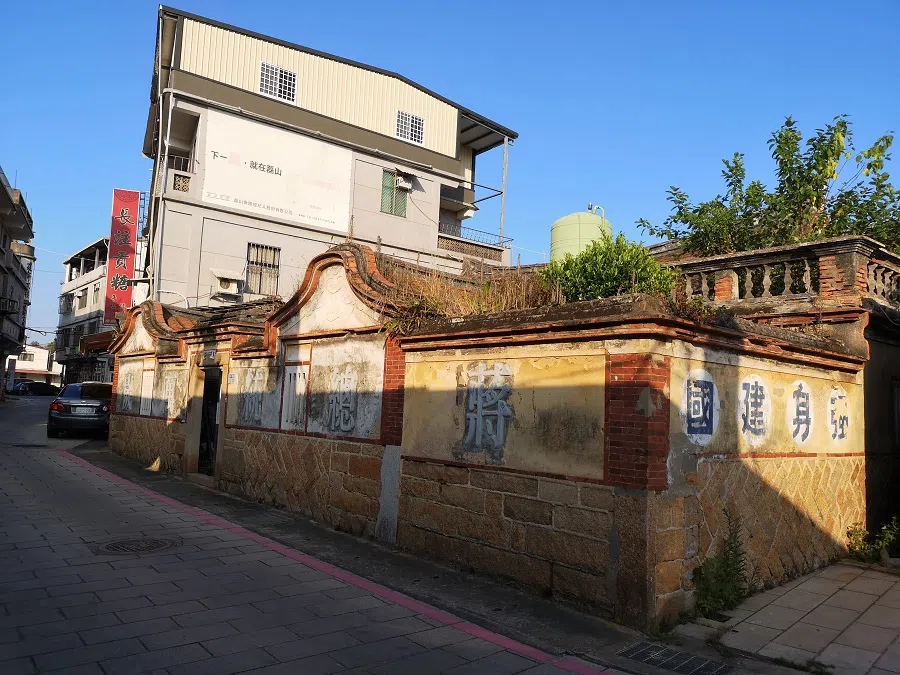

‘Moses Parts the Sea’
Another popular spot for photo-taking is Jiangong Islet, or “Moses Parts the Sea” (摩西分海). This islet at the estuary of Kinmen’s Wujiang River is separated from the main island at high tide, but at low tide, the seawater parts to either side, and one can reach land on foot via the path of stone slabs that was previously underwater.
On both sides of the path stand four three-metre-tall oystermen art installations, which have become a maritime landmark popular with tourists. On the islet is a huge stone statue of Zheng Chenggong facing the sea, corresponding to another stone statue of Zheng that stands on Gulangyu Island in Xiamen.
Visitors to the islet need to know the tide times. During low tide, one can take photos along the exposed stone path while admiring the intertidal zone ecosystem. And after stepping on the islet, what stops people in their tracks is a whole group of military bunkers.
In the early years, the islet was a “Leprosy Reef” to isolate leprosy patients. During the war, its natural advantage of an estuary prompted its redevelopment into a rare island-type fortress...




In the early years, the islet was a “Leprosy Reef” to isolate leprosy patients. During the war, its natural advantage of an estuary prompted its redevelopment into a rare island-type fortress, and it was renamed as “Jiangong Islet”.
On the little islet, camouflage is everywhere; old signs still hang in the empty political and military offices and ammunition rooms; the battered old bunker walls still carry mottled instructions for the usage of guns and artillery. Looking into the distance from a height, the calm surface of the sea at low tide is a crucial point for monitoring the other side of the strait.
It is not advisable to stay too long on the islet, as the tides are outside human control and one has to leave before the tide rises, or get stuck there. The clever combination of timing and geography is crucial in war — the statues of oystermen and Zheng Chenggong are huge and eye-catching, but they cannot mask the islet’s strong strategic significance.
This article was first published in Lianhe Zaobao as “金门“战地”体验 那么近又那么远”.





